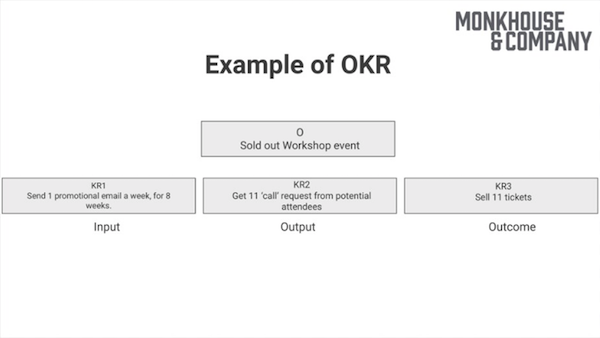You’ve probably heard of OKRs (Objectives and Key Results). You might already be using them. Originally developed as a methodology by Andy Grove at Intel, they were made famous by Google who used them to drive their exponential growth. Soon most of the tech firms in Silicon Valley had adopted them.
Why? Because, very simply, they focus effort. And this is never a bad thing in busy organisations. When we go into companies and talk to front line staff, their main complaints are that management is always starting new initiatives that never get finished. This is usually because there are too many competing priorities. Here’s an interesting fact. The word priority used to be singular. It meant the very first or prior thing. Only in the 1900s was it pluralised – this was illogical. How can multiple things be ‘most important’?
We use OKRs as our methodology of choice to help our clients prioritise their most important activities. They’re a way of bringing agile techniques out of software development and into the core business. Rapid change and iteration are central to their success. And they’re generally used for change initiatives that happen in tandem with business as usual.
Over the years, we’ve seen some work better than others. Based on experience, here are our tips for creating more effective OKRs.
1. Nail down ‘Who, What and When’
The main purpose of OKRs is to describe individual and corporate goals within an organisation. As such, they must nail down ‘Who, What and When’, ensuring clarity on accountability and delivery goals. Maybe they’re time or activity-based – either way, they’ll show progression towards an objective. To illustrate their effectiveness, we often relate them to personal goals.
Say you’ve decided to get fit. Unless you’ve got a proper plan, this isn’t going to happen. Every person has their definition of what being fit looks like – their expectation. So, you need to get specific on the goal and the things you need to achieve to get there. Maybe it’s to run a marathon. OK – when by? Two years from now? Also OK, but how fast do you want to run the marathon?
You set yourself a target of completing the course within five hours and you start planning out the milestones along the way. What progress do you believe you can make in 90 days? With a 70% level of confidence? Take your time on your feet in one session to 90 minutes? Where will you need to be by the end of week 1? Time on your feet is 30 minutes. You can share your progress with your personal trainer at each juncture and take corrective action if you’re falling short.
Approached in this way, OKRs can clarify organisational expectations like nothing else. Everyone will know where they’re heading, how quickly they’re going to get there and their score in real-time.
2. Identify whether OKRs are ‘Committed, Aspirational or Learning’
There are three types of OKRs and it’s useful when you’re writing them, to identify where they sit.
Committed OKRs have no room for falling short – they’re often a sales goal or a revenue target. Aspirational OKRs generally have a lower value on 100% attainment. They are designed to stretch the team, make you feel uncomfortable but still achievable. Getting to 70% of the goal is still deemed a success. Learning OKRs will often test a hypothesis. You might learn that the outcome of the test is negative but that wouldn’t be a failure. It’s the same as testing a scientific theory. Finding something that isn’t true is still a success as that knowledge can carry you forward and inform your next objective.
Here’s an example of an OKR that we use with clients that’s deliberately vague to encourage debate.

The objective is a sold-out workshop event. Where do you reckon this sits? Committed, Aspirational or Learning? Well, it depends – and this gets into why people often fail. If you’ve run plenty of workshops in the past and know that key result 1 (sending 1 promotional email a week for 8 weeks) will work, this is a Committed objective. But if you’ve never sold any workshop tickets before, you’re testing a hypothesis. So it’s a Learning OKR.
If that’s the case, key result 1 is poorly written. Or it needs an outcome key result that links with it. This is because sending 8 emails may not get you closer. You think it will. But you need to measure the response you get from the first week. And maybe change your approach for the second. So depending on the context, you need to adapt the way you write and plan your key results.
3. Come up with three to five key results per objective
Each objective needs three to five key results. These are the milestones on the way to achieving your goal. They need to be specific, time-bound, measurable and verifiable. This is how you know when you’re going off track.
There are three types of key results – Inputs, Outputs and Outcomes. Inputs are things you can control – the actions you’re taking to get to your objective. They might include making a certain number of sales calls or sending a specific volume of emails. Outputs are the things that you produce that are a measuring stick for your OKR – the desired result will be embedded in them. The best Outputs don’t dictate the actions but they allow the team to work out what to do and measure this activity. Outcomes describe the change you’re trying to make. They put into words what will have changed if you’ve achieved the objective.
4. Link the OKR to your BHAG

We always link OKRs back to delivering the organisation’s BHAG. We’re trying to say, ‘This OKR is not describing Business As Usual. It’s about changing something, making progress or learning in line with our overall mission’. All OKRs should link together in this way. Whether they’re individual or corporate – all should have a consistent thread and feed into each other.
5. Set ambitious OKRs
OKRs should be all about boosting performance. And they should minimise sandbagging. They will always have a stretch built-in. This is what distinguishes OKRs from more typical goal-setting exercises where you come up with a goal that is the least your boss will let you get away with. The A in SMART goals is attainable not ambitious that’s why we don’t use this acronym.
For a non-committed OKR, you should measure success as being 70% or above of attainment. So, 90 days out, how certain can you be that you can achieve the objective or key result with 70% as the goal? Scarcity forces innovation. If you don’t know how you’re going to get there, you might have to test, iterate and adapt until you’re closer.
6. Do the risky things first

When you’re planning the milestones of an OKR, always consider doing the riskiest, most unknown activity first. Particularly if it’s a Learning objective where you’re testing a hypothesis and anticipate something new. This ‘Triple R’ approach (which stands for ‘Risk Reduction Rate’) was introduced to me by Karl Blank from Conversion Rate Experts and it’s transformational.
So many initiatives fail at the final hurdle. Time, effort and resources are wasted as people default towards the things they know first. So for every OKR, ask yourself, ‘What is it we don’t know? What do we need to learn? Where are the risks?’ Tackle these first and you’ll find you’re optimising your business for learning.
7. Make sure OKRs are specific
This is a big one and it’s harder than it seems. If the writing is too woolly, you’re less likely to be successful. When you begin writing an objective, set the context at the beginning. One of the questions we ask our clients is, ‘Does this objective deliver incremental change, or a step change, or a discovery?’ Try to write the OKR as an action statement – ‘We’re going to deliver, achieve or measure something.’ Make sure it’s obvious in the writing of the objective how you’ll know that you’ve achieved it.
Avoid being too verbose. If in doubt, make it shorter. And can it be written memorably? Some companies have a corporate style of writing using alliteration or punchy language. This is good. It makes you think about the words you choose and put the effort in to get it right from the start.
8. Commit to a very small number of OKRs
It’s as important to be clear on what you’re NOT going to do as what you are. This is a constant challenge with our clients. We’ll get 5 objectives on the board and someone will always try and sneak in a couple more. People will cry, ‘When do I do my other work?’ It’s hard to get them to stop doing ‘busy work’ that achieves nothing.
When we do retrospectives at the end of each quarter, we look at what the client committed to, how they did against this and what they learned. Two things are often true. a) They wrote the OKR in a way that didn’t allow them to say whether they’d achieved it or b) they said they’d do too many things and it turned out they couldn’t deliver that many. This is a salutary lesson. Don’t over commit. Do less, but better.
9. OKRs should be frequently reviewed
Frequent discussion is vital. Really vital. We recommend at least weekly, even daily check-ins on progress with the metrics and milestones of your key results. In the past, people might have had individual annual goals, given to them in their appraisals (one of my pet hates – ditch them!). Often, they wouldn’t think about these goals until a few weeks before next year’s appraisal meeting. Instead, we recommend replacing annual horizons with quarterly goal setting and weekly/daily reviews of milestones. This really will transform the rhythm and momentum of your business.
10. Make sure OKRs are transparent

Everyone from the CEO downwards should share their OKRs and progress towards them. Total transparency leads to higher levels of personal accountability and trust. It means that people won’t be working on the same things in an unaligned and redundant way. And it shows employees how their activities support company goals, making use of peer pressure when necessary.
In our experience, it takes Executive teams 12 to 18 months to get good at the methodology of OKRs. The discipline involved fits well with Patrick Lencioni’s work in his book ‘The Five Dysfunctions of a Team’. OKRs lead to fanatical attention to results. And this is at the very peak of Lencioni’s triangle describing the characteristics of high performing teams. Correctly executed, they are a fantastic mechanism for continuous improvement and growth.
Written by business coach and leadership coaching expert Dominic Monkhouse. Contact him to schedule a call here. You can order your free copy of his book, Mind Your F**king Business here.

